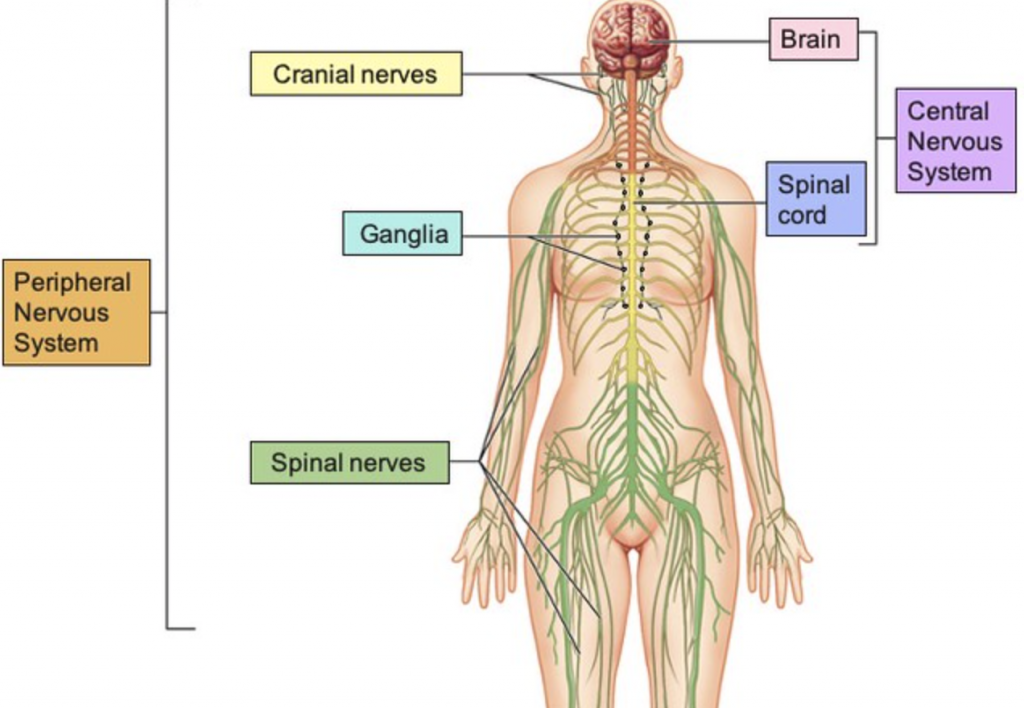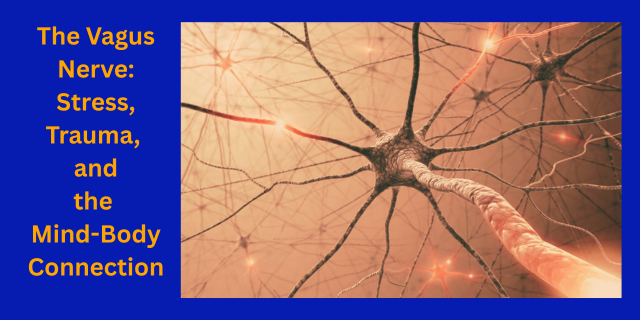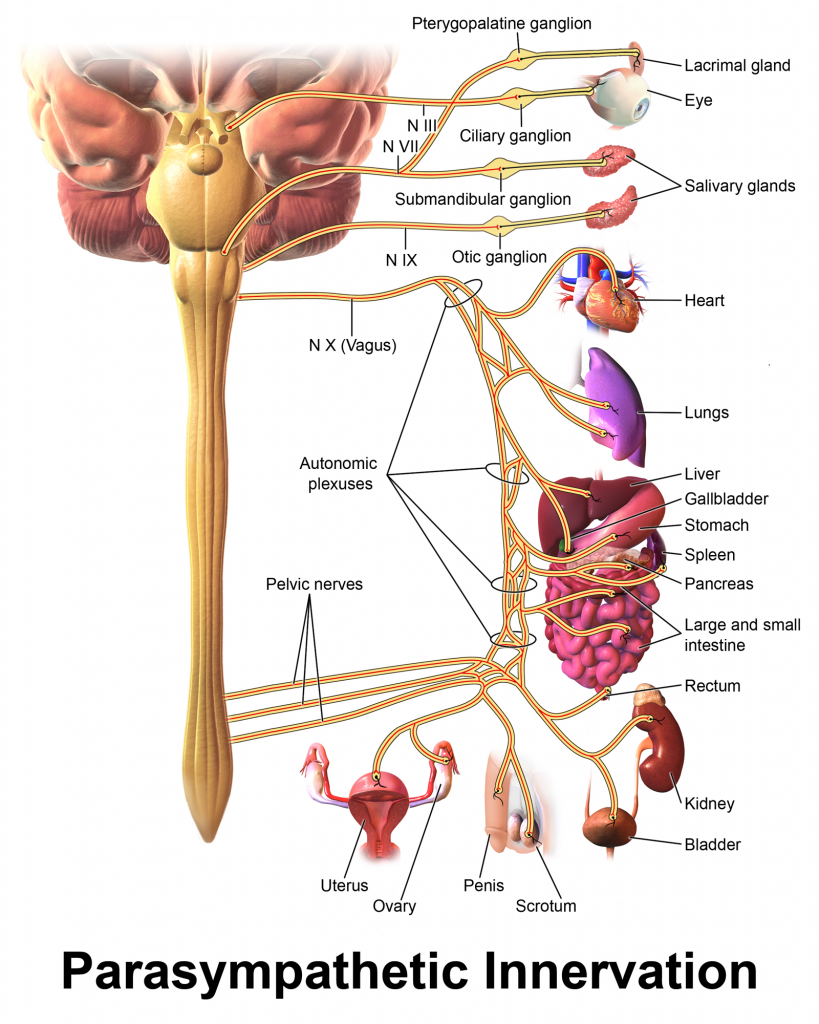We’re going to discus the vagus nerve and no, vagus has nothing to do with Elvis Presley, showgirls or gambling.
It’s part of our complex nervous system!

Your nervous system has two parts: the central nervous system, made up of your brain, eyes and spinal cord; and your peripheral nervous system. Peripheral refers to everything else: the nerves to your muscles and organs and the nerves in your skin.
Your peripheral nervous system is then subdivided into two parts: your autonomic nervous system and your somatic nervous system. Your somatic nervous system contains the nerves to your muscles and the sensory nerves for taste, touch, smell, and sound.
Your autonomic nervous system connects the brain to all your organs. [1 ]
Autonomic Nervous System
There are three activities of the autonomic nervous system: sympathetic, parasympathetic, and enteric.
Sympathetic: You’ve probably heard of the flight or fight response. The sympathetic system is activated when you are unsafe.
Parasympathetic: This is the relaxed, resting mode that is opposite to the sympathetic system.
Enteric: This is the system associated with your stomach, small and large intestines, pancreas, liver and gall bladder: everything involved with digestion. Your gastrointestinal system has as many neurons as your brain and is called the second brain. [2]
Wild Kingdom
Here’s an example of how the autonomic system works in the wild. Imagine watching game on the savana in a National Geographic special. The herd of wildebeest are quietly grazing on the grassland. Their parasympathetic system and enteric system are engaged. Suddenly, the top predator, a lioness, walks around this herd, scoping out the weakest of the lot. Prowling she chooses her target. Her chosen wildebeest alerts and takes flight. Its sympathetic nervous system has engaged.
When the wildebeest is caught; it immediately goes limp. This is its parasympathetic nervous system shutting everything down. It is frozen. However, there is still an opportunity for survival. The wildebeest waits in that frozen state until there is another chance to flee. Then the wildebeest’s sympathetic nervous system can send a fight or flight signal again.
This description illustrates the activity of one of the longest pair of nerves in the body. The 10th nerve, called the wanderer or vagus nerve, is actually a pair of nerves that comes out of the brainstem (medulla oblongata) through the neck and into the chest and the abdomen. As the main component of the parasympathetic nervous system, it is in charge of mood, immune response, heart rate, respiratory rate, and digestion: connecting organs to the brain. It also controls reflexive actions like coughing, sneezing, swallowing and vomiting. [2]
Eighty percent of what this nerve does is bring to information on what is going on in the organs, like heart liver, lungs, of the body up to the brain. [2]
The Vagus Nerve and Health
This nerve seems to do everything. Each nerve of the vagus nerve pair has over 100,000 fibers or strands.
Cardiac Health: The vagus nerve regulates your blood pressure and heart rate. Having what is called high vagal tone means that you have a low resting heart rate and lower blood pressure.
Digestive Health: Regulating when your stomach contracts and empties, all the enzymes, like bile, that are released into your stomach and small intestines, the vagus nerve keeps your digestive system moving properly. Our blood sugar levels rely on the vagus nerve’s involvement in both pancreatic endocrine and exocrine secretion as well as liver glucose production. Problems with your vagus nerve can lead to gastroparesis, irritable bowel syndrome and acid reflux.
Immune Health: The vagus nerve senses cytokines created by innate immune system cells, like macrophages, and sends signals to the brain. The vagus nerve prevents inflammation by regulating the amount of inflammatory cytokines that are produced. [3]
Body-Brain Connection
The philosopher Descartes (1600s) believed in the dualism between the mind/brain and the body. That idea that the brain and body are completely separate has hung on for a long time. Research on the the vagus nerve and its role in connecting the brain and the body has broken down this notion.
Vagus Nerve Stimulation
There has been a long history of experimentation to utilize stimulation of the vagus nerve to stop epileptic seizures. The FDA finally approved vagus nerve stimulation in 1997 to treat adults whose epilepsy did not respond to any other treatment (called medically refractory epilepsy). This is a minimally invasive procedure, using a device that is a lot like a pacemaker. It is implanted surgically and provides electrical pulses to the vagus nerve. As clinicians used this treatment, they noticed a positive side effect in patients—an uplifting of mood and feelings of well-being.[4]
Now there is a new device that has been going through clinical trials by SetPoint Medical. This device is being used to stimulate the vagus nerve for use by people with autoimmune conditions. In one study with patients with rheumatoid arthritis the device reduced symptoms and progression of the disease. [5]
And in searching for a non-invasive procedure, researchers developed something called transcutaneous auricular vagus nerve stimulation or taVNS. The name is a mouthful so I’ll describe what it means. Essentially, parts of the vagus nerve carrying information from the body to the brain (afferent nerves) are located around certain parts of the ear. These portions of the nerve are close enough to the skin for electrical stimulation without surgery. As it is does not require surgery, this treatment is less expensive. Randomized trials have seen positive results in the treatment of insomnia [6]. In another double blind clinical trial found that it can reduce the arousal associated with stress from traumatic memories in people with PTSD. [7] It has also been used to treat epilepsy, prediabetes, depression, and tinnitus. [8]
Using Humming, Deep Breathing and Singing to Stimulate
Compiled in an article in Epilepsy and Behavior entitled, “Can natural ways to stimulate the vagus nerve improve seizure control?” many pilot and smaller studies support the idea that stimulating the vagus nerve through the use of deep breathing, humming, singing and chanting “Om,” can reduce epileptic seizures. [9] In fact, there have been randomized control studies that have shown that listening to Mozart’s Sonata for 2 pianos in D, K.448 reduced the re-occurrence of epileptic seizures in children who listened to the music every evening for 6 months. Other Mozart music had similar effects. [10, 11]
Perhaps, as with epilepsy, using these natural techniques can help with anxiety, depression, and PTSD. Research is needed to support this.
Where To Go From Here
There has been clinically meaningful evidence supporting the importance of the vagus nerve and how it links the immune system, the gut and other organs to the brain. There is also significant evidence that we should not think of the body and brain/mind as separate and distinct. Exciting new opportunities await as we ask the question, where will we go next with these findings?
References:
[1]Breit, S. et al Vagus Nerve as Modulator of the Brain–Gut Axis in Psychiatric and Inflammatory Disorders. Front. Psychiatry, Sec. Psychological Therapy and Psychosomatics. 2018: March; 9. doi:10.3389/fpsyt.2018.00044
[2] Autonomic Nervous System. Cleveland Clinic. https://my.clevelandclinic.org/health/body/23273-autonomic-nervous-system. Accessed April 25, 2025.
[3] Pavlov VA, Tracey KJ. The vagus nerve and the inflammatory reflex–linking immunity and metabolism. Nat Rev Endocrinol. 2012 Dec;8(12):743-54. doi: 10.1038/nrendo.2012.189. PMID: 23169440; PMCID: PMC4082307.
[4] Austelle C, O’Leary G, Thompson S, et.al. A Comprehensive Review of Vagus Nerve Stimulation for Depression Neuromodulation. 2022 April ; 25(3): 309–315. doi:10.1111/ner.13528.
[5] Hamilton, J. Vagus nerve stimulation may tame autoimmune diseases. Shots Health News. NPR. February 3, 2025. https://www.npr.org/sections/shots-health-news/2025/02/03/nx-s1-5272748/vagus-nerve-stimulation-may-tame-autoimmune-diseases. Accessed April 25, 2025.
[6]Zhang S, Zhao Y, Qin Z, et al. Transcutaneous Auricular Vagus Nerve Stimulation for Chronic Insomnia Disorder: A Randomized Clinical Trial. JAMA Netw Open. 2024;7(12):e2451217. doi:10.1001/jamanetworkopen.2024.51217
[7] Gurel NZ, Wittbrodt MT, Jung H, Shandhi MMH, Driggers EG, Ladd SL, Huang M, Ko YA, Shallenberger L, Beckwith J, Nye JA, Pearce BD, Vaccarino V, Shah AJ, Inan OT, Bremner JD. Transcutaneous cervical vagal nerve stimulation reduces sympathetic responses to stress in posttraumatic stress disorder: A double-blind, randomized, sham controlled trial. Neurobiol Stress. 2020 Oct 20;13:100264. doi: 10.1016/j.ynstr.2020.100264. PMID: 33344717; PMCID: PMC7739181.
[8] Kong J, Fang J, Park J, Li S, Rong P. Treating Depression with Transcutaneous Auricular Vagus Nerve Stimulation: State of the Art and Future Perspectives. Front Psychiatry. 2018 Feb 5;9:20. doi: 10.3389/fpsyt.2018.00020. PMID: 29459836; PMCID: PMC5807379.
[9]Yuen A, Sander J. Can natural ways to stimulate the vagus nerve improve seizure control? Epilepsy & Behavior, 2017; 67,105-110.doi:10.1016/j.yebeh.2016.10.039
[10]Coppola G, Toro A, Operto FF, Ferrarioli G, Pisano S, Viggiano A et al. Mozart’s music in children with drug-refractory epileptic encephalopathies. Epilepsy Behav 2015;50:18-22.
[11]Lin LC, Chiang CT, Lee MW, Mok HK, Yang YH, Wu HC et al. Parasympathetic activation is involved in reducing epileptiform discharges when listening to Mozart music. Clin Neurophysiol 2013;124:1528-35.







